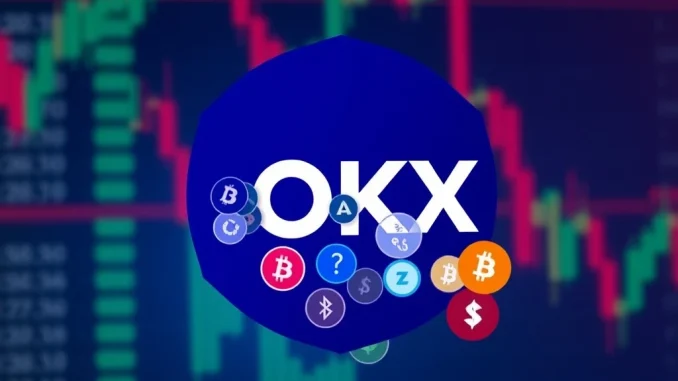
Attention all crypto traders! A significant OKX delisting announcement has just been made, impacting several popular assets. If you’re involved in margin trading pairs on the OKX platform, this crucial update requires your immediate attention to avoid potential disruptions to your portfolio. Understanding these shifts is key to navigating the dynamic world of cryptocurrency, and OKX’s latest decision is no exception.
What’s Behind the Latest OKX Delisting?
OKX Exchange, a leading global cryptocurrency trading platform, has officially announced the removal of seven specific margin trading pairs from its offerings. This OKX delisting is scheduled to take place on July 23 at 11:00 UTC. The announcement, made on the exchange’s official website, serves as a vital piece of information for all users who currently hold or trade these assets.
The affected margin trading pairs are:
- RDNT/USDT
- ID/USDT
- AIDOGE/USDT
- XCH/USDT
- CSPR/USDT
- CTC/USDT
- JOE/USDT
For traders with open positions or pending orders in any of these pairs, it is imperative to take action before the specified deadline. This proactive approach ensures a smooth transition and minimizes any potential losses or inconveniences.
Why Do Crypto Exchanges Announce Delistings?
The decision to initiate a crypto delisting is not made lightly by exchanges. It’s a strategic move often driven by several factors aimed at maintaining a healthy and secure trading environment. Understanding these reasons can help traders anticipate future market movements and make more informed decisions.
Common reasons for exchange announcements regarding delistings include:
- Low Liquidity: If a trading pair consistently shows low trading volume, it becomes difficult for traders to execute orders efficiently without significant price slippage. This can lead to a poor trading experience.
- Project Inactivity or Failure: Projects that cease development, fail to meet their roadmap objectives, or become inactive often lose their utility and appeal, making them candidates for removal.
- Regulatory Concerns: The evolving regulatory landscape can sometimes render certain tokens non-compliant in specific jurisdictions, forcing exchanges to delist them to adhere to legal requirements.
- Performance Issues: Tokens that experience severe price crashes, network vulnerabilities, or other technical issues might be delisted to protect users from further risks.
These factors contribute to an exchange’s ongoing efforts to optimize its offerings and ensure a high-quality trading experience for its users. For OKX, this move likely reflects a similar assessment of the performance and relevance of these specific margin trading pairs.
Navigating the Impact of This OKX Trading Update
For traders holding positions in the affected assets, this OKX trading update can certainly feel concerning. However, understanding the implications and preparing adequately can mitigate potential negative impacts. The primary concern for traders will be the status of their open margin positions and any funds tied to these specific pairs.
Here’s what you need to consider:
- Open Positions: Any open margin positions for RDNT/USDT, ID/USDT, AIDOGE/USDT, XCH/USDT, CSPR/USDT, CTC/USDT, and JOE/USDT will be automatically closed by the exchange at the delisting time. This means your positions will be liquidated based on the market price at that moment.
- Pending Orders: All pending orders (limit, stop-limit, etc.) for these crypto pairs will be canceled automatically. It’s crucial to review your active orders and ensure you don’t have any lingering instructions for these assets.
- Asset Management: While the trading pairs are delisted, the underlying assets (RDNT, ID, AIDOGE, etc.) will typically remain in your spot wallet. However, their liquidity might be significantly reduced, and you would need to find alternative exchanges or wallets to manage them.
This is a standard procedure during delistings, but it requires traders to be vigilant and proactive. The aim is to provide sufficient notice for users to manage their portfolios before the automated closures take effect.
Your Action Plan for Affected Crypto Pairs
Given the upcoming OKX delisting, timely action is essential. Don’t wait until the last minute to manage your assets. Here are some actionable insights and steps you should consider taking:
- Close Open Positions: If you have any open margin positions for the listed pairs, it is highly recommended to close them manually before July 23, 11:00 UTC. This allows you to control the exit price rather than relying on an automated closure, which might occur at an unfavorable moment.
- Cancel Pending Orders: Review your active orders and cancel any pending buy or sell orders related to these margin trading pairs.
- Withdraw or Convert Assets: After closing positions, consider withdrawing the affected cryptocurrencies to a personal wallet or transferring them to another exchange where they are still traded. Alternatively, you might choose to convert them to more liquid assets like USDT before the delisting date.
- Stay Informed: Always refer to the official OKX website or their official communication channels for the most accurate and up-to-date information regarding this delisting and any subsequent announcements.
- Review Your Portfolio: Use this opportunity to review your overall crypto portfolio and risk exposure, especially concerning less liquid or niche assets.
Taking these steps will help you navigate this change effectively and minimize any potential disruption to your trading strategy. The key is to be proactive and informed.
In conclusion, OKX’s decision to delist seven margin trading pairs on July 23 is a significant development that all affected users must address promptly. While such exchange announcements can seem daunting, they are often part of an exchange’s ongoing effort to refine its offerings and maintain a healthy trading environment. By understanding the reasons behind a crypto delisting and taking the recommended actions, traders can effectively manage their assets and continue their journey in the crypto market. Always prioritize staying informed and acting swiftly on critical OKX trading update notices to protect your investments.
Frequently Asked Questions (FAQs)
Q1: Which specific margin trading pairs are being delisted by OKX?
A1: OKX is delisting seven margin trading pairs: RDNT/USDT, ID/USDT, AIDOGE/USDT, XCH/USDT, CSPR/USDT, CTC/USDT, and JOE/USDT.
Q2: When will the delisting of these pairs take place?
A2: The delisting is scheduled for July 23 at 11:00 UTC.
Q3: What should I do if I have open positions or pending orders for these pairs?
A3: It is strongly recommended to close all open margin positions and cancel any pending orders for these pairs before the delisting time (July 23, 11:00 UTC). Any remaining positions or orders will be automatically closed/canceled by the system.
Q4: Why does OKX delist certain assets or trading pairs?
A4: Exchanges typically delist assets due to factors like low liquidity, project inactivity, regulatory concerns, or performance issues to maintain a healthy and compliant trading environment.
Q5: Will my funds be lost if I don’t act before the delisting?
A5: While the trading pairs will be removed, the underlying cryptocurrencies (e.g., RDNT, ID) will generally remain in your spot wallet. However, their trading availability on OKX will cease, and you might need to withdraw or transfer them to another platform for trading or holding.
Q6: Where can I find the official announcement from OKX regarding this delisting?
A6: You can find the official announcement on the OKX Exchange’s official website or their official communication channels, such as their blog or support pages.



